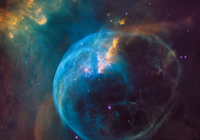Space Odyssey
Light pollution and cloud coverage often obscure views of the night sky and stars above. Enter Stellarium for the PC; this free, open source program can make even distant galaxies visible to the user.
|

NASA
Light pollution and cloud coverage often obscure views of the night sky and stars above. Enter Stellarium for the PC; this free, open source program can make even distant galaxies visible to the user.
Fabien Chéreau released the first version of Stellarium back in 2001 as a free, open source software package. Since then, developers have continued working to drive the software forward. Version 0.14.2 [1] was released in January 2016. Even so, version 0.13 is available in the source packages for all of the common distributions and is sufficient for most purposes. The current version has an advantage in that the developers corrected an annoying scripting error that had occurred in all previous versions. The software can be updated via the commands in Listing 1. A package or updates obtained from an unofficial source may contain defects.
The concept underlying this software was introduced in a previous issue of Ubuntu User [2]. Additional user options deal with augmenting information about the astronomical objects and using scripting for controlling the display of the sky.
The basic Stellarium package contains data for approximately 600,000 stars with brightness of at least 10.5 magnitude (magnitude refers to the apparent brightness of stars). Under optimal conditions, humans can see around 6,000 stars, with magnitude 6 stars being the smallest discernible by the naked eye. This means that Stellarium displays the night skies as they are seen by the naked eye but also shows celestial objects that would otherwise be visible only through a telescope. For the user, the star catalogs offered by Stellarium are therefore important (see the "Star Catalogs" box for details).
[...]
Pages: 7
What shines in the dark is often hidden by clouds. Stellarium provides a clear view of the stars plus a lot of astronomical data.
© 2026 Linux New Media USA, LLC – Legal Notice